
The chemistry of isatins a review from 1975 to 1999
.pdf
Please use CPS: orgchem/0010004 in any reference to this article
71
O
N |
O |
KCN |
|
||
|
(NH4)2CO3 |
|
|
|
(47%) |
O
NH
HN
O
O
N
Scheme 92
Isatins can be used as the electrophilic component in the Wittig-Horner reaction with
phosphonates and furnish products resulting from attack at position C-3378,379. Other α - carboxyphosphonates380 and α -carboxyphosphites381 have also been studied and yield 3- methyleneoxindoles in moderate yields (Scheme 93).
O |
O |
|
|
O |
|
|
(RO)2P |
|
|
O |
|
|
O |
|
|
|
|
N |
|
O |
H |
|
|
|
N |
|
|
|
|
|
|
H |
Scheme 93
1-Alkyl and 1-acylisatin react with equimolar quantities of a succinyl triphenylphosphorylidene to give dimethyl 2-oxoindolin-3-ylidenesuccinate derivatives in low yields382 (Scheme 94). Dimers of this product are obtained from the reaction of isatin-3-(4- chlorophenyl)imine with DMAD in the presence of cupric acetate383.
When the Wittig reaction is carried out with two equivalents of the Wittig reagent, 3-spiro-cyclopropanes are formed384 (Scheme 94).
This article is available from: http://preprint.chemweb.com/orgchem/0010004 Uploaded 17 October 2000 at 14:44 GMT
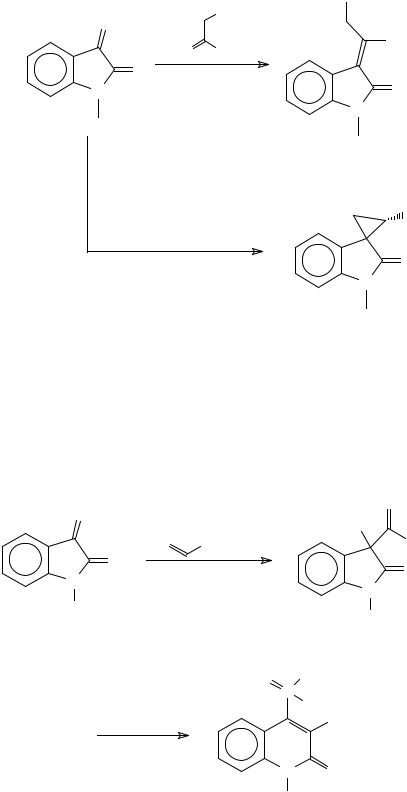
Please use CPS: orgchem/0010004 in any reference to this article
72
|
CO2Me |
CO2Me |
|
O |
|
||
|
CO2Me |
||
Φ 3P |
CO2Me |
||
|
|||
O |
(13%) |
O |
|
N |
|||
|
N
R R
R
Ph3PCHR (2 eq.) (21-74%)
O
N
Scheme 94
α -Diazophosphorous derivatives also attack at the C-3 position of the isatin ring to
give dioxindoles385,386 which upon treatment with acid yield the ring expanded quinolones
(Scheme 95).
O |
N2 |
|
HO |
||
|
N2 |
POR1R2 |
O |
Et2NH |
N |
R
POR1R2
O
N
R
(56-94%)
O |
P |
R2 |
|
R1 |
OH |
||
HCl |
|
|
|
|
|
|
|
|
N |
|
O |
R
(59-99%)
Scheme 95
This article is available from: http://preprint.chemweb.com/orgchem/0010004 Uploaded 17 October 2000 at 14:44 GMT
Please use CPS: orgchem/0010004 in any reference to this article
73
3-Alkyldioxindoles and their dehydration products, 3-methyleneoxindoles, are formed in the reactions of isatins with organoboron compounds, such as triallylboron387; organomagnesium reagents388,389; organozinc reagents390,391 ; organolithium reagents392,393, such as methyllithium154. These compounds are also obtained in aldolic and related condensations with acetone394 or its oxime395; aromatic396,397 and heteroaromatic methylketones398,399; cyclic alkylketones400; acetates401; propionates402; acetoacetates403; cyanoacetates404; nitroalkanes405; benzodiazepinones406; imidazolinones407; indoles408; 2- methylquinolines409; pyrazinones410; thiazolidinediones411-415 and xanthinones416
In the reaction of isatins with some cyclic ketones, such as 4-hydroxy-2H-benzopyran-2- one417, the initial dioxindole formed reacts with a second equivalent of the ketone yielding a 3,3-disubstituted oxindole.
The addition of methyl lithium to isatin-3,3-dimethylketal (3,3-dimethoxyoxindole) at room temperature for 2.5 min lead to an indolenine derivative through addition at C-2 and substitution of one methoxy group at C-3. By extending the reaction time to 3 hours, the second methoxy group was also substituted, furnishing 2,3,3-trimethylindolenine. This same product was obtained when the reaction was carried out at 0 oC, together with 3,3- dimethyloxindole418 (Scheme 96).
This article is available from: http://preprint.chemweb.com/orgchem/0010004 Uploaded 17 October 2000 at 14:44 GMT
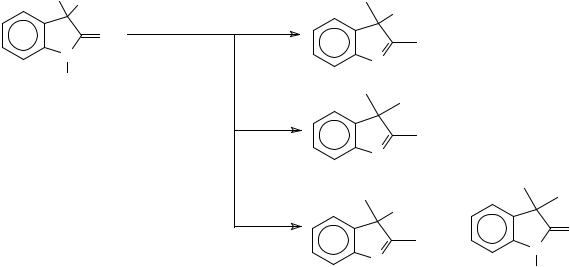
Please use CPS: orgchem/0010004 in any reference to this article
74
MeO OMe |
|
OMe |
|
MeLi |
rt |
|
|
|
|
||
O |
2.5 min |
|
|
N |
N |
|
|
|
|
||
H |
|
|
|
|
|
|
|
|
rt |
|
|
|
3 h |
N |
|
|
|
|
|
|
0 oC |
OMe |
|
|
+ |
O |
|
|
3 h |
||
|
N |
||
|
|
N |
|
|
|
H |
|
|
|
|
Scheme 96
Isatins fail to yield Knoevenagel condensation products with malonic acid419. However, malonic acid can be condensed with isatin in a mixture of ethanol and pyridine, in which the initial condensation product suffers decarboxylation, furnishing an acetic acid derivative. This can be converted to the acid chloride and submitted to a Friedel-Crafts acylation reaction, yielding acetophenone derivatives420. Alternatively the oxoindolinylidene acetic acid derivative can be treated with an arene in the presence of AlCl3 to yield spiro[indoline-3,3’- indan]-2,1-dione derivatives421.
Microwave irradiation has been used for promoting the reaction of isatin with malononitrile to give 3-dicyanomethyleneoxindole and gives better results in comparison to the usual method422. The dielectric properties of this condensation product have been studied423.
The dehydration of the dioxindoles can be achieved by treatment with a mixture of HCl and AcOH424,425. The 3-methyleneoxindoles can be selectively reduced at the carboncarbon double bond using Na2S2O4 in aqueous ethanol426,427 (Scheme 97).
This article is available from: http://preprint.chemweb.com/orgchem/0010004 Uploaded 17 October 2000 at 14:44 GMT
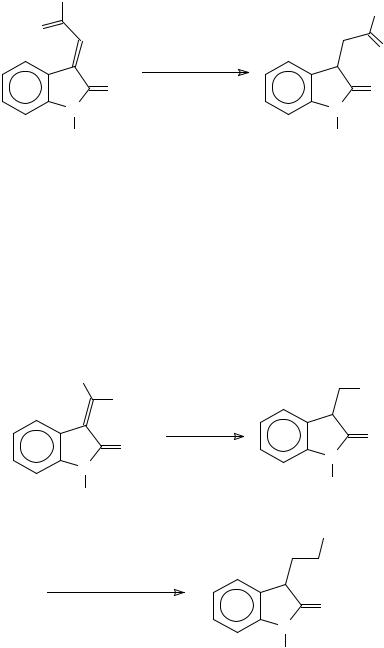
Please use CPS: orgchem/0010004 in any reference to this article
75
Ar
Ar
O
|
Na2S2O4 |
O |
|
|
|
O |
EtOH, H2O |
O |
N |
(57-92%) |
N |
|
||
H |
|
H |
Scheme 97
The condensation products from the reactions of isatins with cyanoacetates can be reduced at the carbon-carbon double bond with Zn dust in HCl or by hydrogenation with Pd/C. Subsequent decarboxylation can be achieved by refluxing in 2-ethoxyethanol. Further reduction of the nitrile yields an ethylamine oxindole428 (Scheme 98).
NC |
|
CN |
|
CO2R |
|
||
1) Zn/HCl |
|
||
|
or H2/Pd-C |
O |
|
O |
2) 2-Ethoxy |
||
N |
|||
N |
ethanol, ∆ |
||
R' |
|||
R' |
|
||
|
|
||
|
|
NH2 |
|
H2/Pt |
|
|
|
(46-87%) |
|
O |
|
|
|
N |
|
|
|
R' |
Scheme 98
The total synthesis of the marine natural products surugatoxin429-432 and neosurugatoxin435,436 began with a Knovenagel condensation employing 6-bromoisatin (Scheme 99).
This article is available from: http://preprint.chemweb.com/orgchem/0010004 Uploaded 17 October 2000 at 14:44 GMT
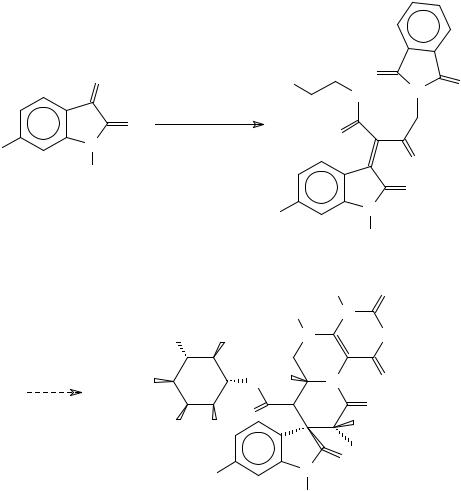
Please use CPS: orgchem/0010004 in any reference to this article
76
|
O |
MeS |
|
O |
N |
O |
|
|
O |
||||
|
|
|
|
|
||
|
O |
|
|
O |
|
|
Br |
N |
|
|
|
|
|
|
|
|
O |
|
||
|
H |
|
|
|
|
|
|
|
|
|
O |
|
|
|
|
|
|
|
|
|
|
|
Br |
|
N |
|
|
|
|
|
|
H |
|
|
|
|
|
|
H |
O |
|
|
|
H |
|
N |
|
|
|
HO |
OH |
N |
|
NH |
|
|
HO |
O HO |
|
N |
O |
|
|
|
O |
|
O |
|
|
|
|
|
OH |
|
|
|
|
HO |
OH |
|
|
|
|
|
|
|
|
|
||
|
|
Br |
N |
O |
|
|
|
|
|
|
|
H
Surugatoxin
Scheme 99
An important issue with respect to the Knovenagel condensation is that a mixture of isomeric disubstituted 3-methyleneoxindoles can be obtained. 1H NMR measurements, including nOe experiments, and quantum chemical calculations have also shown that 3- [cyano(ethoxycarbonyl)methylene]-2-oxindoles, which are obtained from the reaction of isatin or from 1-methylisatin with ethyl cyanoacetate, exist as a mixture of the E and Z isomers, and that the E isomer exists in an equilibrium between two conformers, trans-s-cis and trans-s-trans437 (Scheme 100).
This article is available from: http://preprint.chemweb.com/orgchem/0010004 Uploaded 17 October 2000 at 14:44 GMT
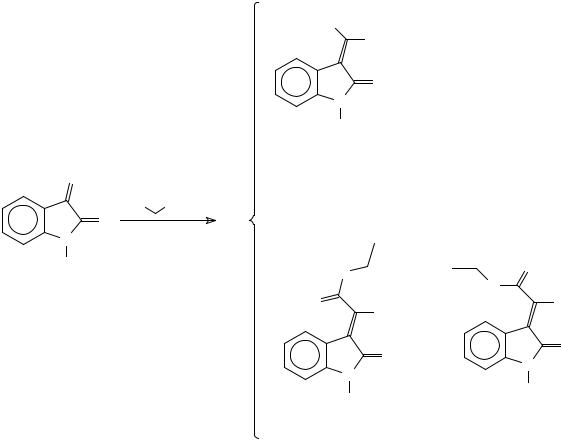
Please use CPS: orgchem/0010004 in any reference to this article
77
NC |
|
|
|
CO2Et |
|
|
O |
|
|
N |
|
|
R |
|
O |
Z |
|
NC CO2Et |
+ |
|
O |
|
|
N |
|
|
R |
O |
O |
|
O |
|
O |
|
|
CN |
CN |
|
|
+ |
|
|
|
|
|
O |
O |
|
N |
|
|
N |
|
|
R |
|
|
R |
|
|
|
|
E (trans-s-cis) |
E (trans-s-trans) |
|
Scheme 100
D.R. Long and co-workers have studied monosubstituted 3-methyleneoxindoles and for most of them only the E isomer could be detected. 2-Oxoindolin-3-ylideneacetonitrile exists as a separable E,Z-pair, but the Z-isomer slowly isomerises when dissolved in
dimethylsulfoxide438.
The Darzens reaction of isatin with ethyl chloroacetate yields glycidic esters. Alkaline hydrolysis of the glycidic esters yields indole-2,3-dicarboxylic and indole-3-carboxylic acids in a 6:1 proportion. The isolation of two isomeric glycidic esters, and the fact that both produce the indolecarboxylic acids in the same proportion led to a mechanistic proposal for the formation of the later through a common intermediate439 (Scheme 101).
This article is available from: http://preprint.chemweb.com/orgchem/0010004 Uploaded 17 October 2000 at 14:44 GMT
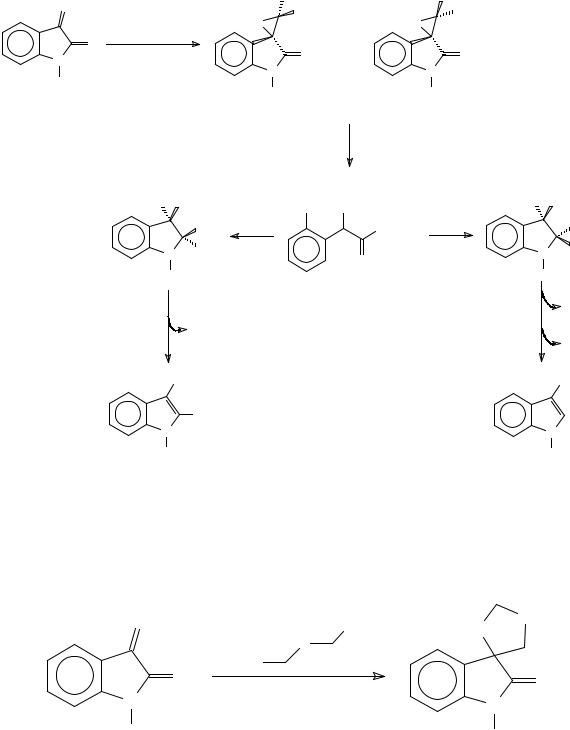
Please use CPS: orgchem/0010004 in any reference to this article
78
O |
|
|
|
|
H |
|
H |
|
|
|
|
|
|
CO2Et |
|
CO2Et |
|
|
|
|
|
ClCH2CO2Et |
|
O |
|
O |
|
|
|
|
O |
|
|
+ |
|
|
|
||
|
NaOEt |
|
|
O |
O |
|
|
||
N |
|
|
|
|
|
|
|||
|
|
|
|
N |
|
N |
|
|
|
R |
|
|
|
|
|
|
|
||
|
|
|
|
R |
|
R |
|
|
|
|
|
|
|
|
|
|
|
||
|
|
|
|
|
|
1) NaOH |
|
|
|
|
|
|
|
|
|
2) HCl |
|
|
|
|
|
H |
CO2- |
|
NHR CO2- |
H |
CO2- |
|
|
|
|
|
OH |
- |
|
CO2- |
|
OH |
- |
|
|
N |
CO |
|
|
N |
CO |
||
|
|
2 |
|
O |
2 |
||||
|
|
R |
|
|
|
R |
|
|
|
|
|
|
|
|
|
|
|
||
|
|
|
|
|
|
|
|
CO2 |
|
|
|
|
H2O |
|
|
|
|
H2O |
|
|
|
|
|
|
|
|
|
|
|
|
|
CO2H |
|
|
|
|
CO2H |
|
|
|
|
N |
CO2H |
|
|
N |
|
||
|
|
|
|
|
|
|
|||
|
|
R |
|
|
|
|
R |
|
|
Scheme 101
Masked carbanions, such as silanes, also react with isatins at position 3 and this
methodology has been applied to the synthesis of 1,3-oxathiolanes440,441 (Scheme 102).
O |
|
Cl |
O |
S |
|
|
|
||
|
|
S |
|
|
|
O |
Me3Si |
|
O |
N |
CsF, MeCN |
|
||
|
N |
|
||
|
|
|
||
R |
|
|
R |
|
|
|
|
(66-86%) |
|
Scheme 102
This article is available from: http://preprint.chemweb.com/orgchem/0010004 Uploaded 17 October 2000 at 14:44 GMT
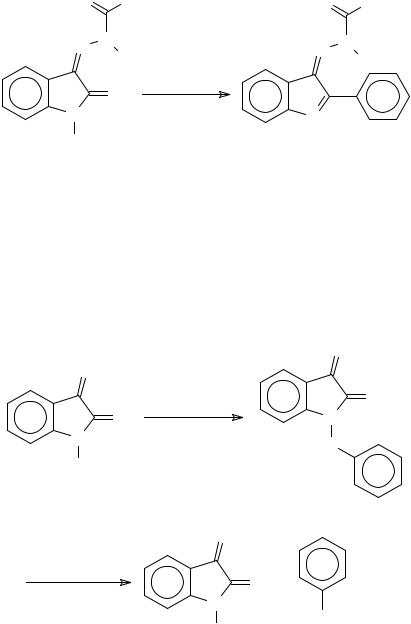
Please use CPS: orgchem/0010004 in any reference to this article
79
The reactions of some isatin derivatives with organometallic reagents follow reaction patterns that differ from those of isatin. Addition of phenylmagnesium bromide to isatin-3- acylhydrazones gave a product resulting from nucleophilic attack at C-2442 (Scheme 103).
O R O R
N N H N N H
O PhMgBr
(30-50%)
N N H
Scheme 103
On the other hand, addition of Grignard or organolithium reagents to 1- (arylthio)isatins led to cleavage of the N-S bond and formation of the respective sulfides443
(Scheme 104).
O
O |
PhSCl, Et3N |
N |
(82%) |
|
H
O
O
N
S
O
R'MgBr (55-75%)
O +
N
SR'
H
Scheme 104
2,2-Dimethoxy-1-methylpyrrolidine adds to isatin in a unique manner furnishing an α -
diketone through an intermediate α -ketoester444 and the proposed mechanism is shown in
This article is available from: http://preprint.chemweb.com/orgchem/0010004 Uploaded 17 October 2000 at 14:44 GMT
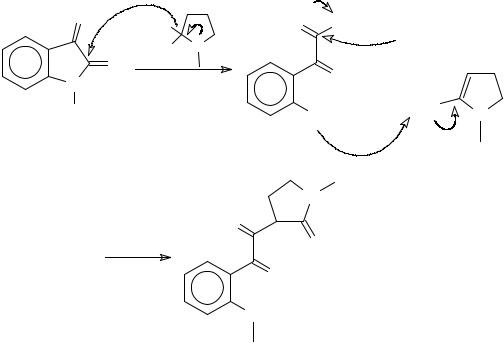
Please use CPS: orgchem/0010004 in any reference to this article
80
Scheme 105. When the reaction was performed with the lactam acetal, 2,2- dimethoxytetrahydroazepine, the product obtained was 1-methylisatin444,445.
O
O
N
MeO
MeO N
O  OMe
OMe
O + 
H |
NH2 |
MeO |
N |
|
N
O
O
(55%) |
O |
|
NH
Scheme 105
Different reaction pathways can be observed in the reaction of isatins with carbanions under photochemical or thermal conditions. Thus, the reaction of isatin and isoxazolone under thermal conditions led to addition at position C-3, whilst under UV irradiation cleavage of the isatinic N1-C2 bond occured yielding isatic acid, which subsequently condensed with isoxazolone446 (Scheme 106).
This article is available from: http://preprint.chemweb.com/orgchem/0010004 Uploaded 17 October 2000 at 14:44 GMT
